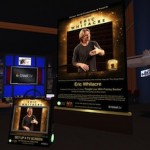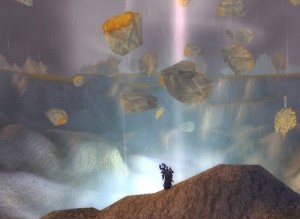 1. VentureBeat (USA) – Sony’s Home virtual world hits 17M users and finds a business model in virtual goods. “Two years after its debut, Sony’s Home online virtual world for PlayStation gamers has hit 17 million users worldwide. The virtual community has now grown into a gathering place where gamers can play hundreds of games, attend droves of events, and buy lots of virtual goods. The multi-year effort is becoming Sony’s big play in the digital online marketplace for video game fans. Along with user growth, Home’s revenues have also begun to take off, said Jack Buser (pictured below), director of PlayStation Home at Sony, in an interview today. Home is a virtual world on the PlayStation Network where you can create a realistic animated avatar and wander among virtual sites such as shopping malls, movie theaters, or game arcades. Back in the summer, when Sony launched a new indie game effort in Home, it had 14 million users.”
1. VentureBeat (USA) – Sony’s Home virtual world hits 17M users and finds a business model in virtual goods. “Two years after its debut, Sony’s Home online virtual world for PlayStation gamers has hit 17 million users worldwide. The virtual community has now grown into a gathering place where gamers can play hundreds of games, attend droves of events, and buy lots of virtual goods. The multi-year effort is becoming Sony’s big play in the digital online marketplace for video game fans. Along with user growth, Home’s revenues have also begun to take off, said Jack Buser (pictured below), director of PlayStation Home at Sony, in an interview today. Home is a virtual world on the PlayStation Network where you can create a realistic animated avatar and wander among virtual sites such as shopping malls, movie theaters, or game arcades. Back in the summer, when Sony launched a new indie game effort in Home, it had 14 million users.”
2. Philadelphia Inquirer (USA) – Virtual justice: Online game world meets real-world cops and courts. “When Tim Quirino needed cash to help him get through his senior year at Drexel University, he knew what to sell. His ad on eBay read something like this – Available: World of Warcraft avatar ranked second in his realm, plus his castle, virtual gold, weapons, and other accessories. Within a week, he pocketed a very real $1,000 for a very unreal set of assets. Fortunately for Quirino, now 26, the transaction was a smooth one. He got his money, graduated with a degree in graphic design, and went on to cofound the popular-culture blog Geekadelphia. But the murkier side of virtual worlds – where incidents of theft and fraud, along with assault and bullying, are on the rise – increasingly has real-world cops and courts intervening. Their involvement hasn’t ended the confusion.”
3. Tonic (USA) – World of Warcraft’s Virtual Pets Help the Real World. “Game on. World of Warcraft, the game with a player population bigger than most countries, isn’t letting its capacity for social change go untapped. From now until Dec. 31, World of Warcraft players can buy a Moonkin Hatchling (it’s the cute one in the photo) for $10 to use in their virtual worlds, and $5 of the purchase price will go to the Make-A-Wish Foundation to help kids struggling in the real world. The charity pet has a unique talent — it will plant flowers at your avatar’s feet and dance with anyone it finds who’s willing. Somebody call Cute Overload.”
4. Pittsburgh Post Gazette (USA) – CMU virtual world show lures headhunters to town. “Ian Bowie would seem to have no reason to be nervous this weekend. The 100-hour weeks the 27-year-old level designer from Colorado put in this semester at Carnegie Mellon University’s Entertainment Technology Center had paid off. Three of the virtual worlds he helped design — out of the 14 chosen from 60 entries — were included in two presentations Saturday of Building Virtual Worlds, shown before raucous, standing-room-only crowds at the Philip Chosky Theater on the CMU campus. The virtual worlds ranged from the crowd-pleasing “The Great Illusionist”, in which a real person on stage did magic tricks with a person on a video screen — to the squeamish “Five Days”, which had a person wearing a head-mounted interactive monitor saw off part of a trapped leg in a virtual world — to disturbing “Teddy”, one of the teams Mr. Bowie was on that featured a creepy teddy bear haunting a hospital patient.”
5. VentureBeat (USA) – Next Island launches its time traveler’s virtual world. “After more than 2.5 years in the making, Next Island is quietly launching its ambitious virtual world with a time travel theme. The brainchild of serial entrepreneur David Post, the new world is now available for people to visit and is getting a once-over from journalists. By January, Post will trumpet the site to consumers at large. The enterprise is a test of whether virtual worlds have a place in the modern landscape of gaming, where most of the excitement revolves around social games such as FarmVille, mobile games such as Angry Birds, or traditional console games and PC online titles such as World of Warcraft.”
6. New York Times (USA) – On a Hunt for What Makes Gamers Keep Gaming. “By the age of 21, the typical American has spent 10,000 hours playing computer games, and endured a smaller but much drearier chunk of time listening to sermons about this sinful habit. Why, the experts wail, are so many people wasting their lives solving meaningless puzzles in virtual worlds Rules like “buy low, sell high†and “tall people are sexier†play out exactly the same way, whether the environment is virtual or real. Now some other experts — ones who have actually played these games — are asking more interesting questions. Why are these virtual worlds so much more absorbing than school and work? How could these gamers’ labors be used to solve real-world puzzles? Why can’t life be more like a video game? “Gamers are engaged, focused, and happy,†says Edward Castronova, a professor of telecommunications at Indiana University who has studied and designed online games. “How many employers wish they could say that about even a tenth of their work force?”
7. Hypergrid Business (Hong Kong) – ProtoSphere and Lync: more than voice. “Last week, ProtonMedia made a formal announcement about a project I first reported on in September of this year that ProtoSphere, the 3D enterprise collaboration and learning tool, is now fully integrated with Microsoft’s Lync Server 2010. The Lync server is a software product that unifies enterprise voice, instant messaging and web-, audio- and videoconferencing into a, connected communications experience. Here is a video that explains the relationship of how ProtoSphere sits on top of Lync and SharePoint and the capabilities of the platform with Ron Burns, President of ProtonMedia and Albert Kooiman, Sr. Technical Product Manager of Microsoft Lync.”
8. Internet Evolution (USA) – C-Suite Seeks ‘True’ Telepresence. “For some CEOs, the concept of telepresence inspires both great confusion and great interest. Most would classify it as a videoconferencing solution with high-definition screens, while others with global offices see it as a saver of costs otherwise spent on travel. CoStar Group, which provides information services to commercial real estate professionals in 30 worldwide offices, is one company that has adopted telepresence technologies. On average, the company of more than 1,000 researchers is conducting an estimated 40 to 50 video conferences every day and as many as 10,000 video conferences per year, with some employees using video up to 5 hours a day. CoStar CEO Andrew Florance says his company saves as much as $5 million per year on travel expenses thanks to video chat.”
9. PC World (USA) – World of Warcraft Cataclysm Launch Smooth So Far. “Well we made it, we’re still here, the servers are operational, the random disconnects were few, the lag wasn’t intolerable, and the World of Warcraft will never be the same. Cataclysm launched worldwide this morning while most of us slept. It was, you have to admit, a trifle anticlimactic. After all, some of the biggest game world changes occurred weeks ago. That’s when Blizzard rebooted Azeroth, wrecking the place and blaming it on a dragon no one’s seen yet. Storylines were revamped, new quests added, races and classes overhauled, the earth and heavens rearranged, and the interface refined enough to make several add-ons superfluous. Last night the final pieces unlocked: Two new playable races, Worgen for Alliance and Goblin for Horde, new high-level zones for characters level 80 to 85, guild achievements and leveling for group advancement, and, best of all, the option to fly your mounts around Kalimdor and the Eastern Kingdoms. Yes, that last means the world just got a lot more dangerous for noobs working mainland PvP zones.”
10. Asbury Park Press (USA) – NO ESCAPING VIRTUAL WORLD. “The event “Video Games Live” has toured the country with its repertoire of music and visual effects, highlighting compositions from games like “Mario,” “ChronoCross,” “Final Fantasy VII,” “Bioshock,” “Mass Effect,” “Warcraft,” “Zelda,” “MegaMan” and others. But as you can tell from that list, traditional classical music fans are really not the principal target audience for this program.”









Recent Comments